(All information courtesy of the instrument teams.)
![]() Previous IAU Circulars
Previous IAU Circulars
TITLE: GCN/SWIFT NOTICE
NOTICE_DATE: Thu 03 Mar 16 10:55:15 UT
NOTICE_TYPE: Swift-BAT GRB Position
TRIGGER_NUM: 677495, Seg_Num: 0
GRB_RA: 168.681d {+11h 14m 44s} (J2000),
168.896d {+11h 15m 35s} (current),
168.017d {+11h 12m 04s} (1950)
GRB_DEC: +22.742d {+22d 44' 33"} (J2000),
+22.654d {+22d 39' 15"} (current),
+23.015d {+23d 00' 54"} (1950)
GRB_ERROR: 3.00 [arcmin radius, statistical only]
GRB_INTEN: 1496 [cnts] Image_Peak=116 [image_cnts]
TRIGGER_DUR: 0.256 [sec]
TRIGGER_INDEX: 481 E_range: 50-350 keV
BKG_INTEN: 22181 [cnts]
BKG_TIME: 39272.07 SOD {10:54:32.07} UT
BKG_DUR: 8 [sec]
GRB_DATE: 17450 TJD; 63 DOY; 16/03/03
GRB_TIME: 39282.05 SOD {10:54:42.05} UT
GRB_PHI: -171.22 [deg]
GRB_THETA: 22.59 [deg]
SOLN_STATUS: 0x3
RATE_SIGNIF: 29.41 [sigma]
IMAGE_SIGNIF: 8.20 [sigma]
MERIT_PARAMS: +1 +0 +0 -2 +3 -1 +0 +0 +95 +0
SUN_POSTN: 344.61d {+22h 58m 26s} -6.56d {-06d 33' 47"}
SUN_DIST: 163.39 [deg] Sun_angle= 11.7 [hr] (West of Sun)
MOON_POSTN: 270.38d {+18h 01m 32s} -18.21d {-18d 12' 40"}
MOON_DIST: 107.16 [deg]
MOON_ILLUM: 35 [%]
GAL_COORDS: 218.91, 67.68 [deg] galactic lon,lat of the burst (or transient)
ECL_COORDS: 160.52, 16.42 [deg] ecliptic lon,lat of the burst (or transient)
COMMENTS: SWIFT-BAT GRB Coordinates.
COMMENTS: This is a rate trigger.
COMMENTS: A point_source was found.
COMMENTS: This does not match any source in the on-board catalog.
COMMENTS: This does not match any source in the ground catalog.
COMMENTS: This is a GRB.
COMMENTS: This trigger occurred at longitude,latitude = 161.57,-17.33 [deg].
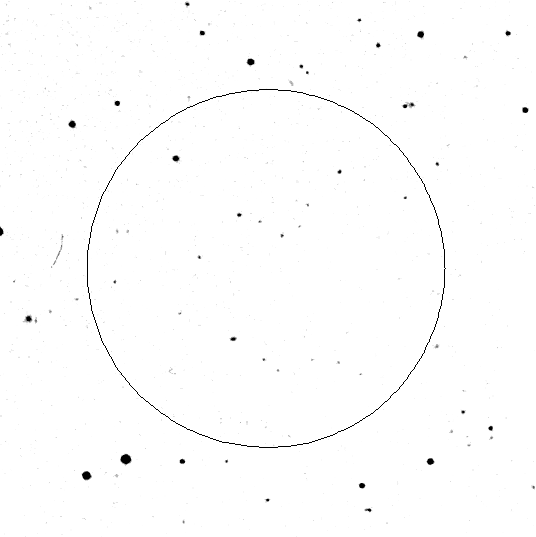
TITLE: GCN/INTEGRAL NOTICE
NOTICE_DATE: Thu 03 Mar 16 10:55:18 UT
NOTICE_TYPE: INTEGRAL SPI ACS Trigger
TRIGGER_NUM: 7385, Sub_Num: 0
GRB_INTEN: 11.74 [sigma]
GRB_TIME: 39282.17 SOD {10:54:42.17} UT
GRB_DATE: 17450 TJD; 63 DOY; 16/03/03
COMMENTS: INTEGRAL SPI_ACS GRB Trigger.
COMMENTS: Time_Scale=0.2000 and Time_Error=0.1000.
COMMENTS:
COMMENTS: NOTE: This SPIACS event is temporally(0.0<100sec) coincident with the
+SWIFT_BAT event (trignum=677495).
COMMENTS:
COMMENTS: The SPIACS lightcurve can be found at:
COMMENTS: ftp://isdcarc.unige.ch/arc/FTP/ibas/spiacs/2016-03/2016-03-03T10-54-42.0603-25944-56208+-0.lc
TITLE: GCN/SWIFT NOTICE
NOTICE_DATE: Thu 03 Mar 16 10:56:51 UT
NOTICE_TYPE: Swift-XRT Nack-Position
TRIGGER_NUM: 677495, Seg_Num: 0
POINT_RA: 168.702d {+11h 14m 49s} (J2000)
POINT_DEC: +22.757d {+22d 45' 27"} (J2000)
IMG_START_DATE: 17450 TJD; 63 DOY; 16/03/03
IMG_START_TIME: 39386.18 SOD {10:56:26.18} UT, 104.1 [sec] since BAT Trigger Time
COUNTS: 37 Min_needed= 20
STD_DEV: 0.00 Max_StdDev_for_Good=28.44 [arcsec]
PH2_ITER: 4 Max_iter_allowed= 4
ERROR_CODE: 2
COMMENTS: SWIFT-XRT Nack Position.
COMMENTS: Algorithm did not converge; too many iterations.
TITLE: GCN/SWIFT NOTICE
NOTICE_DATE: Thu 03 Mar 16 10:58:35 UT
NOTICE_TYPE: Swift-BAT GRB Lightcurve
TRIGGER_NUM: 677495, Seg_Num: 0
GRB_RA: 168.681d {+11h 14m 44s} (J2000),
168.896d {+11h 15m 35s} (current),
168.017d {+11h 12m 04s} (1950)
GRB_DEC: +22.742d {+22d 44' 33"} (J2000),
+22.654d {+22d 39' 15"} (current),
+23.015d {+23d 00' 54"} (1950)
GRB_DATE: 17450 TJD; 63 DOY; 16/03/03
GRB_TIME: 39282.05 SOD {10:54:42.05} UT
TRIGGER_INDEX: 481
GRB_PHI: -171.22 [deg]
GRB_THETA: 22.59 [deg]
DELTA_TIME: -37.00 [sec]
TRIGGER_DUR: 0.256 [sec]
SOLN_STATUS: 0x3
RATE_SIGNIF: 29.41 [sigma]
IMAGE_SIGNIF: 8.20 [sigma]
LC_URL: sw00677495000msb.lc
SUN_POSTN: 344.61d {+22h 58m 26s} -6.56d {-06d 33' 44"}
SUN_DIST: 163.39 [deg] Sun_angle= 11.7 [hr] (West of Sun)
MOON_POSTN: 270.41d {+18h 01m 40s} -18.21d {-18d 12' 42"}
MOON_DIST: 107.18 [deg]
MOON_ILLUM: 35 [%]
GAL_COORDS: 218.91, 67.68 [deg] galactic lon,lat of the burst (or transient)
ECL_COORDS: 160.52, 16.42 [deg] ecliptic lon,lat of the burst (or transient)
COMMENTS: SWIFT-BAT GRB Lightcurve.
COMMENTS:
COMMENTS: The next comments were copied from the BAT_POS Notice:
COMMENTS: This is a rate trigger.
COMMENTS: A point_source was found.
COMMENTS: This does not match any source in the on-board catalog.
COMMENTS: This does not match any source in the ground catalog.
COMMENTS: This is a GRB.
COMMENTS: This trigger occurred at longitude,latitude = 161.57,-17.33 [deg].
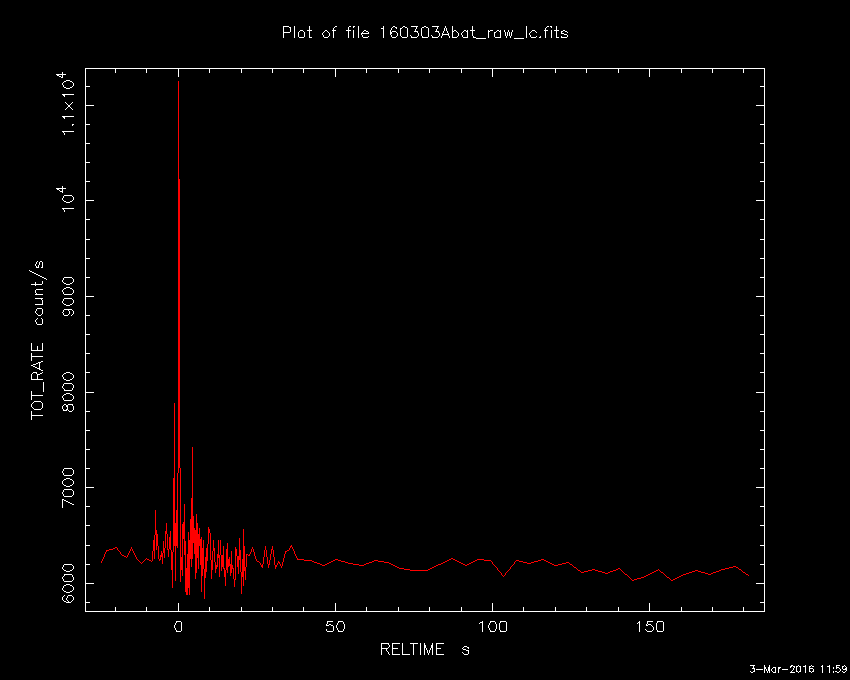
TITLE: GCN/SWIFT NOTICE
NOTICE_DATE: Thu 03 Mar 16 10:59:26 UT
NOTICE_TYPE: Swift-UVOT Source List
TRIGGER_NUM: 677495, Seg_Num: 0
POINT_RA: 168.702d {+11h 14m 48s} (J2000)
POINT_DEC: +22.757d {+22d 45' 25"} (J2000)
POINT_ROLL: 14.277d
IMG_START_DATE: 17450 TJD; 63 DOY; 16/03/03
IMG_START_TIME: 39390.93 SOD {10:56:30.93} UT, 108.9 [sec] since BAT Trigger Time
FILTER: 10, White
BKG_MEAN: 2.367
N_STARS: 10
X_OFFSET: 309 [pixels]
Y_OFFSET: 516 [pixels]
X_MAX: 1268 [pixels]
Y_MAX: 1475 [pixels]
DET_THRESH: 13
PHOTO_THRESH: 7
SL_URL: sw00677495000msufc0108.fits
SUN_POSTN: 344.61d {+22h 58m 26s} -6.56d {-06d 33' 43"}
SUN_DIST: 163.37 [deg] Sun_angle= 11.7 [hr] (West of Sun)
MOON_POSTN: 270.42d {+18h 01m 41s} -18.21d {-18d 12' 42"}
MOON_DIST: 107.18 [deg]
MOON_ILLUM: 35 [%]
GAL_COORDS: 218.89, 67.70 [deg] galactic lon,lat of the pointing direction
ECL_COORDS: 160.53, 16.44 [deg] ecliptic lon,lat of the pointing direction
COMMENTS: SWIFT-UVOT Source List.
TITLE: GCN/SWIFT NOTICE
NOTICE_DATE: Thu 03 Mar 16 10:59:45 UT
NOTICE_TYPE: Swift-UVOT Processed Source List
TRIGGER_NUM: 677495, Seg_Num: 0
POINT_RA: 168.702d {+11h 14m 48s} (J2000)
POINT_DEC: +22.757d {+22d 45' 25"} (J2000)
POINT_ROLL: 14.277d
IMG_START_DATE: 17450 TJD; 63 DOY; 16/03/03
IMG_START_TIME: 39390.93 SOD {10:56:30.93} UT, 108.9 [sec] since BAT Trigger Time
FILTER: 10, White
BKG_MEAN: 2.367
N_STARS: 10
X_OFFSET: 309 [pixels]
Y_OFFSET: 516 [pixels]
X_MAX: 1268 [pixels]
Y_MAX: 1475 [pixels]
DET_THRESH: 13
PHOTO_THRESH: 7
SL_URL: sw00677495000msufc0108.fits
SUN_POSTN: 344.61d {+22h 58m 26s} -6.56d {-06d 33' 42"}
SUN_DIST: 163.37 [deg] Sun_angle= 11.7 [hr] (West of Sun)
MOON_POSTN: 270.43d {+18h 01m 42s} -18.21d {-18d 12' 42"}
MOON_DIST: 107.18 [deg]
MOON_ILLUM: 35 [%]
GAL_COORDS: 218.89, 67.70 [deg] galactic lon,lat of the pointing direction
ECL_COORDS: 160.53, 16.44 [deg] ecliptic lon,lat of the pointing direction
COMMENTS: SWIFT-UVOT Processed Source List.
COMMENTS: All 4 attachments are included.
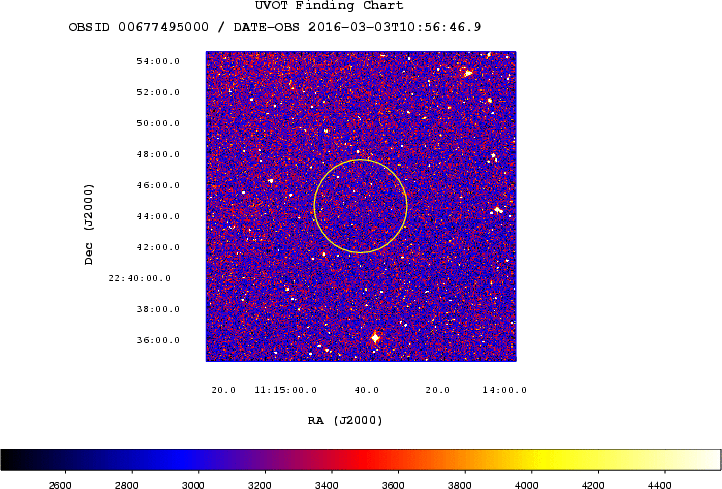
TITLE: GCN/SWIFT NOTICE
NOTICE_DATE: Thu 03 Mar 16 11:00:54 UT
NOTICE_TYPE: Swift-UVOT Image
TRIGGER_NUM: 677495, Seg_Num: 0
POINT_RA: 168.702d {+11h 14m 48s} (J2000)
POINT_DEC: +22.757d {+22d 45' 25"} (J2000)
ROLL: 14.277d
IMG_START_DATE: 17450 TJD; 63 DOY; 16/03/03
IMG_START_TIME: 39390.93 SOD {10:56:30.93} UT, 108.9 [sec] since BAT Trigger Time
FILTER: 10, White
EXPOSURE_ID: 478695406
X_OFFSET: 628 [pixels]
Y_OFFSET: 835 [pixels]
WIDTH: 160 [pixels]
HEIGHT: 160 [pixels]
X_GRB_POS: 788
Y_GRB_POS: 995
BINNING_INDEX: 1
IM_URL: sw00677495000msuni0124.fits
SUN_POSTN: 344.61d {+22h 58m 27s} -6.56d {-06d 33' 41"}
SUN_DIST: 163.37 [deg] Sun_angle= 11.7 [hr] (West of Sun)
MOON_POSTN: 270.44d {+18h 01m 45s} -18.21d {-18d 12' 43"}
MOON_DIST: 107.19 [deg]
MOON_ILLUM: 35 [%]
GAL_COORDS: 218.89, 67.70 [deg] galactic lon,lat of the pointing direction
ECL_COORDS: 160.53, 16.44 [deg] ecliptic lon,lat of the pointing direction
COMMENTS: SWIFT-UVOT Image.
COMMENTS: The GRB Position came from the Window Position in the Mode Command.
COMMENTS: The image has 2x2 binning (compression).
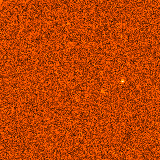
TITLE: GCN/SWIFT NOTICE
NOTICE_DATE: Thu 03 Mar 16 11:01:11 UT
NOTICE_TYPE: Swift-UVOT Processed Image
TRIGGER_NUM: 677495, Seg_Num: 0
POINT_RA: 168.702d {+11h 14m 48s} (J2000)
POINT_DEC: +22.757d {+22d 45' 25"} (J2000)
ROLL: 14.277d
IMG_START_DATE: 17450 TJD; 63 DOY; 16/03/03
IMG_START_TIME: 39390.93 SOD {10:56:30.93} UT, 108.9 [sec] since BAT Trigger Time
FILTER: 10, White
EXPOSURE_ID: 478695406
X_OFFSET: 628 [pixels]
Y_OFFSET: 835 [pixels]
WIDTH: 160 [pixels]
HEIGHT: 160 [pixels]
X_GRB_POS: 788
Y_GRB_POS: 995
BINNING_INDEX: 1
IM_URL: sw00677495000msuni0124.fits
SUN_POSTN: 344.61d {+22h 58m 27s} -6.56d {-06d 33' 41"}
SUN_DIST: 163.37 [deg] Sun_angle= 11.7 [hr] (West of Sun)
MOON_POSTN: 270.44d {+18h 01m 45s} -18.21d {-18d 12' 43"}
MOON_DIST: 107.19 [deg]
MOON_ILLUM: 35 [%]
GAL_COORDS: 218.89, 67.70 [deg] galactic lon,lat of the pointing direction
ECL_COORDS: 160.53, 16.44 [deg] ecliptic lon,lat of the pointing direction
COMMENTS: SWIFT-UVOT Processed Image.
COMMENTS: The GRB Position came from the Window Position in the Mode Command.
COMMENTS: The image has 2x2 binning (compression).
COMMENTS: All 4 attachments are included.
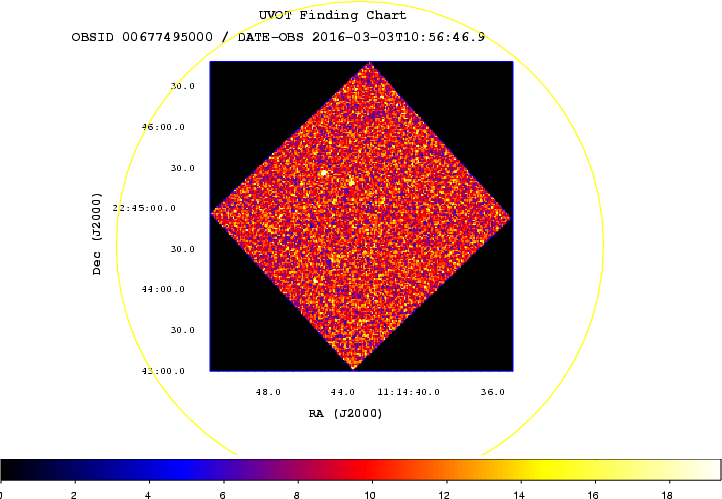
TITLE: GCN/SWIFT NOTICE
NOTICE_DATE: Thu 03 Mar 16 11:03:19 UT
NOTICE_TYPE: Swift-XRT Position
TRIGGER_NUM: 677495, Seg_Num: 0
GRB_RA: 168.6999d {+11h 14m 47.97s} (J2000),
168.9144d {+11h 15m 39.45s} (current),
168.0357d {+11h 12m 08.56s} (1950)
GRB_DEC: +22.7412d {+22d 44' 28.3"} (J2000),
+22.6529d {+22d 39' 10.4"} (current),
+23.0139d {+23d 00' 49.9"} (1950)
GRB_ERROR: 3.7 [arcsec radius, statistical plus systematic, 90% containment]
GRB_INTEN: 1.00e-10 [erg/cm2/sec]
GRB_SIGNIF: 10.00 [sigma]
IMG_START_DATE: 17450 TJD; 63 DOY; 16/03/03
IMG_START_TIME: 39398.00 SOD {10:56:38.00} UT, 115.9 [sec] since BAT Trigger Time
TAM[0-3]: 100.00 100.00 100.00 100.00
AMPLIFIER: 1
WAVEFORM: 31
SUN_POSTN: 344.61d {+22h 58m 27s} -6.56d {-06d 33' 39"}
SUN_DIST: 163.38 [deg] Sun_angle= 11.7 [hr] (West of Sun)
MOON_POSTN: 270.46d {+18h 01m 50s} -18.21d {-18d 12' 44"}
MOON_DIST: 107.21 [deg]
MOON_ILLUM: 35 [%]
GAL_COORDS: 218.93, 67.69 [deg] galactic lon,lat of the burst
ECL_COORDS: 160.54, 16.43 [deg] ecliptic lon,lat of the burst
COMMENTS: SWIFT-XRT Coordinates.
COMMENTS: This Notice was ground-generated -- not flight-generated.
COMMENTS: TAM values, flux and significance fields are not valid.
COMMENTS: This position was automatically generated on the ground using
COMMENTS: Photon Counting data telemetered via TDRSS (SPER data).
COMMENTS: See http://www.swift.ac.uk/sper/docs.php for details.
COMMENTS: The probability that this is a serendipitous source in the
COMMENTS: SPER window is 1.1% < P(seren) < 2.8%.
TITLE: GCN/SWIFT NOTICE
NOTICE_DATE: Thu 03 Mar 16 11:07:45 UT
NOTICE_TYPE: Swift-UVOT Source List
TRIGGER_NUM: 677495, Seg_Num: 0
POINT_RA: 168.703d {+11h 14m 49s} (J2000)
POINT_DEC: +22.756d {+22d 45' 20"} (J2000)
POINT_ROLL: 14.281d
IMG_START_DATE: 17450 TJD; 63 DOY; 16/03/03
IMG_START_TIME: 39602.91 SOD {11:00:02.91} UT, 320.9 [sec] since BAT Trigger Time
FILTER: 7, U
BKG_MEAN: 0.639
N_STARS: 18
X_OFFSET: 69 [pixels]
Y_OFFSET: 276 [pixels]
X_MAX: 1508 [pixels]
Y_MAX: 1715 [pixels]
DET_THRESH: 7
PHOTO_THRESH: 3
SL_URL: sw00677495000msufc0320.fits
SUN_POSTN: 344.62d {+22h 58m 28s} -6.56d {-06d 33' 35"}
SUN_DIST: 163.37 [deg] Sun_angle= 11.7 [hr] (West of Sun)
MOON_POSTN: 270.50d {+18h 02m 00s} -18.21d {-18d 12' 45"}
MOON_DIST: 107.24 [deg]
MOON_ILLUM: 35 [%]
GAL_COORDS: 218.90, 67.70 [deg] galactic lon,lat of the pointing direction
ECL_COORDS: 160.54, 16.44 [deg] ecliptic lon,lat of the pointing direction
COMMENTS: SWIFT-UVOT Source List.
TITLE: GCN/SWIFT NOTICE
NOTICE_DATE: Thu 03 Mar 16 11:08:04 UT
NOTICE_TYPE: Swift-UVOT Processed Source List
TRIGGER_NUM: 677495, Seg_Num: 0
POINT_RA: 168.703d {+11h 14m 49s} (J2000)
POINT_DEC: +22.756d {+22d 45' 20"} (J2000)
POINT_ROLL: 14.281d
IMG_START_DATE: 17450 TJD; 63 DOY; 16/03/03
IMG_START_TIME: 39602.91 SOD {11:00:02.91} UT, 320.9 [sec] since BAT Trigger Time
FILTER: 7, U
BKG_MEAN: 0.639
N_STARS: 18
X_OFFSET: 69 [pixels]
Y_OFFSET: 276 [pixels]
X_MAX: 1508 [pixels]
Y_MAX: 1715 [pixels]
DET_THRESH: 7
PHOTO_THRESH: 3
SL_URL: sw00677495000msufc0320.fits
SUN_POSTN: 344.62d {+22h 58m 28s} -6.56d {-06d 33' 34"}
SUN_DIST: 163.37 [deg] Sun_angle= 11.7 [hr] (West of Sun)
MOON_POSTN: 270.50d {+18h 02m 01s} -18.21d {-18d 12' 45"}
MOON_DIST: 107.25 [deg]
MOON_ILLUM: 35 [%]
GAL_COORDS: 218.90, 67.70 [deg] galactic lon,lat of the pointing direction
ECL_COORDS: 160.54, 16.44 [deg] ecliptic lon,lat of the pointing direction
COMMENTS: SWIFT-UVOT Processed Source List.
COMMENTS: All 4 attachments are included.
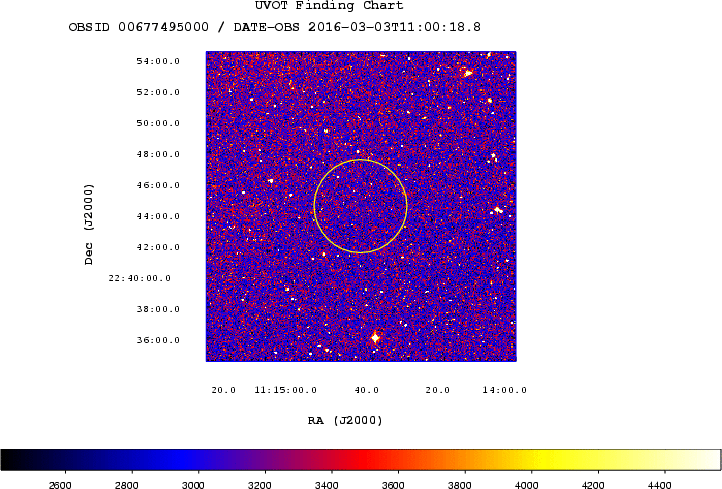
TITLE: GCN/SWIFT NOTICE
NOTICE_DATE: Thu 03 Mar 16 11:08:16 UT
NOTICE_TYPE: Swift-XRT Position UPDATE
TRIGGER_NUM: 677495, Seg_Num: 0
GRB_RA: 168.7005d {+11h 14m 48.12s} (J2000),
168.9150d {+11h 15m 39.59s} (current),
168.0363d {+11h 12m 08.71s} (1950)
GRB_DEC: +22.7424d {+22d 44' 32.6"} (J2000),
+22.6541d {+22d 39' 14.7"} (current),
+23.0151d {+23d 00' 54.3"} (1950)
GRB_ERROR: 2.2 [arcsec radius, statistical plus systematic, 90% containment]
GRB_INTEN: 1.00e-10 [erg/cm2/sec]
GRB_SIGNIF: 10.00 [sigma]
IMG_START_DATE: 17450 TJD; 63 DOY; 16/03/03
IMG_START_TIME: 39398.00 SOD {10:56:38.00} UT, 115.9 [sec] since BAT Trigger Time
TAM[0-3]: 100.00 100.00 100.00 100.00
AMPLIFIER: 1
WAVEFORM: 31
SUN_POSTN: 344.62d {+22h 58m 28s} -6.56d {-06d 33' 34"}
SUN_DIST: 163.38 [deg] Sun_angle= 11.7 [hr] (West of Sun)
MOON_POSTN: 270.51d {+18h 02m 01s} -18.21d {-18d 12' 46"}
MOON_DIST: 107.25 [deg]
MOON_ILLUM: 35 [%]
GAL_COORDS: 218.93, 67.70 [deg] galactic lon,lat of the burst
ECL_COORDS: 160.54, 16.43 [deg] ecliptic lon,lat of the burst
COMMENTS: SWIFT-XRT Coordinates.
COMMENTS: This Notice was ground-generated -- not flight-generated.
COMMENTS: This is an Update Notice -- the RA,Dec values herein supersede the previous XRT_POS Notice.
COMMENTS: TAM values, flux and significance fields are not valid.
COMMENTS: This position was automatically generated on the ground using
COMMENTS: Photon Counting data telemetered via TDRSS (SPER data).
COMMENTS: See http://www.swift.ac.uk/sper/docs.php for details.
COMMENTS: This position was enhanced using UVOT field astrometry.
COMMENTS: The probability that this is a serendipitous source in the
COMMENTS: SPER window is 1.1% < P(seren) < 2.8%.
TITLE: GCN/SWIFT NOTICE
NOTICE_DATE: Thu 03 Mar 16 11:09:17 UT
NOTICE_TYPE: Swift-UVOT Image
TRIGGER_NUM: 677495, Seg_Num: 0
POINT_RA: 168.703d {+11h 14m 49s} (J2000)
POINT_DEC: +22.756d {+22d 45' 20"} (J2000)
ROLL: 14.281d
IMG_START_DATE: 17450 TJD; 63 DOY; 16/03/03
IMG_START_TIME: 39602.91 SOD {11:00:02.91} UT, 320.9 [sec] since BAT Trigger Time
FILTER: 7, U
EXPOSURE_ID: 478695618
X_OFFSET: 628 [pixels]
Y_OFFSET: 835 [pixels]
WIDTH: 160 [pixels]
HEIGHT: 160 [pixels]
X_GRB_POS: 788
Y_GRB_POS: 995
BINNING_INDEX: 1
IM_URL: sw00677495000msuni0336.fits
SUN_POSTN: 344.62d {+22h 58m 28s} -6.56d {-06d 33' 33"}
SUN_DIST: 163.37 [deg] Sun_angle= 11.7 [hr] (West of Sun)
MOON_POSTN: 270.51d {+18h 02m 04s} -18.21d {-18d 12' 46"}
MOON_DIST: 107.26 [deg]
MOON_ILLUM: 35 [%]
GAL_COORDS: 218.90, 67.70 [deg] galactic lon,lat of the pointing direction
ECL_COORDS: 160.54, 16.44 [deg] ecliptic lon,lat of the pointing direction
COMMENTS: SWIFT-UVOT Image.
COMMENTS: The GRB Position came from the Window Position in the Mode Command.
COMMENTS: The image has 2x2 binning (compression).
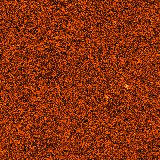
TITLE: GCN/SWIFT NOTICE
NOTICE_DATE: Thu 03 Mar 16 11:09:36 UT
NOTICE_TYPE: Swift-UVOT Processed Image
TRIGGER_NUM: 677495, Seg_Num: 0
POINT_RA: 168.703d {+11h 14m 49s} (J2000)
POINT_DEC: +22.756d {+22d 45' 20"} (J2000)
ROLL: 14.281d
IMG_START_DATE: 17450 TJD; 63 DOY; 16/03/03
IMG_START_TIME: 39602.91 SOD {11:00:02.91} UT, 320.9 [sec] since BAT Trigger Time
FILTER: 7, U
EXPOSURE_ID: 478695618
X_OFFSET: 628 [pixels]
Y_OFFSET: 835 [pixels]
WIDTH: 160 [pixels]
HEIGHT: 160 [pixels]
X_GRB_POS: 788
Y_GRB_POS: 995
BINNING_INDEX: 1
IM_URL: sw00677495000msuni0336.fits
SUN_POSTN: 344.62d {+22h 58m 28s} -6.56d {-06d 33' 33"}
SUN_DIST: 163.37 [deg] Sun_angle= 11.7 [hr] (West of Sun)
MOON_POSTN: 270.52d {+18h 02m 04s} -18.21d {-18d 12' 46"}
MOON_DIST: 107.26 [deg]
MOON_ILLUM: 35 [%]
GAL_COORDS: 218.90, 67.70 [deg] galactic lon,lat of the pointing direction
ECL_COORDS: 160.54, 16.44 [deg] ecliptic lon,lat of the pointing direction
COMMENTS: SWIFT-UVOT Processed Image.
COMMENTS: The GRB Position came from the Window Position in the Mode Command.
COMMENTS: The image has 2x2 binning (compression).
COMMENTS: All 4 attachments are included.
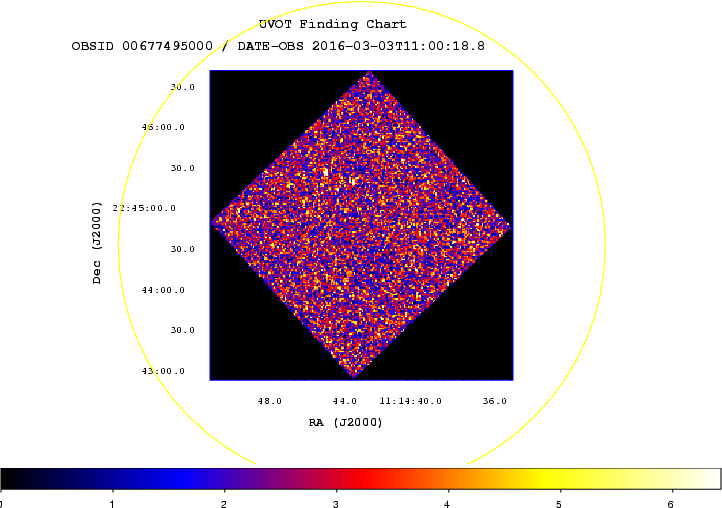
TITLE: GCN/SWIFT NOTICE
NOTICE_DATE: Thu 03 Mar 16 11:13:15 UT
NOTICE_TYPE: Swift-UVOT Source List
TRIGGER_NUM: 677495, Seg_Num: 0
POINT_RA: 168.703d {+11h 14m 49s} (J2000)
POINT_DEC: +22.756d {+22d 45' 21"} (J2000)
POINT_ROLL: 14.280d
IMG_START_DATE: 17450 TJD; 63 DOY; 16/03/03
IMG_START_TIME: 40156.21 SOD {11:09:16.21} UT, 874.2 [sec] since BAT Trigger Time
FILTER: 10, White
BKG_MEAN: 2.474
N_STARS: 28
X_OFFSET: 69 [pixels]
Y_OFFSET: 276 [pixels]
X_MAX: 1508 [pixels]
Y_MAX: 1715 [pixels]
DET_THRESH: 13
PHOTO_THRESH: 7
SL_URL: sw00677495000msufc0874.fits
SUN_POSTN: 344.62d {+22h 58m 29s} -6.56d {-06d 33' 29"}
SUN_DIST: 163.37 [deg] Sun_angle= 11.7 [hr] (West of Sun)
MOON_POSTN: 270.55d {+18h 02m 12s} -18.21d {-18d 12' 47"}
MOON_DIST: 107.29 [deg]
MOON_ILLUM: 35 [%]
GAL_COORDS: 218.90, 67.70 [deg] galactic lon,lat of the pointing direction
ECL_COORDS: 160.54, 16.44 [deg] ecliptic lon,lat of the pointing direction
COMMENTS: SWIFT-UVOT Source List.
TITLE: GCN/SWIFT NOTICE
NOTICE_DATE: Thu 03 Mar 16 11:13:36 UT
NOTICE_TYPE: Swift-UVOT Processed Source List
TRIGGER_NUM: 677495, Seg_Num: 0
POINT_RA: 168.703d {+11h 14m 49s} (J2000)
POINT_DEC: +22.756d {+22d 45' 21"} (J2000)
POINT_ROLL: 14.280d
IMG_START_DATE: 17450 TJD; 63 DOY; 16/03/03
IMG_START_TIME: 40156.21 SOD {11:09:16.21} UT, 874.2 [sec] since BAT Trigger Time
FILTER: 10, White
BKG_MEAN: 2.474
N_STARS: 28
X_OFFSET: 69 [pixels]
Y_OFFSET: 276 [pixels]
X_MAX: 1508 [pixels]
Y_MAX: 1715 [pixels]
DET_THRESH: 13
PHOTO_THRESH: 7
SL_URL: sw00677495000msufc0874.fits
SUN_POSTN: 344.62d {+22h 58m 29s} -6.56d {-06d 33' 29"}
SUN_DIST: 163.37 [deg] Sun_angle= 11.7 [hr] (West of Sun)
MOON_POSTN: 270.56d {+18h 02m 13s} -18.21d {-18d 12' 48"}
MOON_DIST: 107.29 [deg]
MOON_ILLUM: 35 [%]
GAL_COORDS: 218.90, 67.70 [deg] galactic lon,lat of the pointing direction
ECL_COORDS: 160.54, 16.44 [deg] ecliptic lon,lat of the pointing direction
COMMENTS: SWIFT-UVOT Processed Source List.
COMMENTS: All 4 attachments are included.
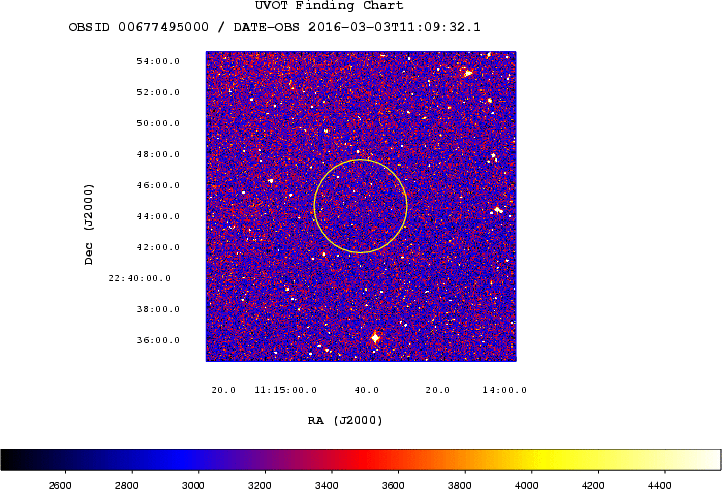
TITLE: GCN/SWIFT NOTICE
NOTICE_DATE: Thu 03 Mar 16 11:14:45 UT
NOTICE_TYPE: Swift-UVOT Image
TRIGGER_NUM: 677495, Seg_Num: 0
POINT_RA: 168.703d {+11h 14m 49s} (J2000)
POINT_DEC: +22.756d {+22d 45' 21"} (J2000)
ROLL: 14.280d
IMG_START_DATE: 17450 TJD; 63 DOY; 16/03/03
IMG_START_TIME: 40156.21 SOD {11:09:16.21} UT, 874.2 [sec] since BAT Trigger Time
FILTER: 10, White
EXPOSURE_ID: 478696172
X_OFFSET: 628 [pixels]
Y_OFFSET: 835 [pixels]
WIDTH: 160 [pixels]
HEIGHT: 160 [pixels]
X_GRB_POS: 788
Y_GRB_POS: 995
BINNING_INDEX: 1
IM_URL: sw00677495000msuni0890.fits
SUN_POSTN: 344.62d {+22h 58m 29s} -6.56d {-06d 33' 28"}
SUN_DIST: 163.37 [deg] Sun_angle= 11.7 [hr] (West of Sun)
MOON_POSTN: 270.57d {+18h 02m 16s} -18.21d {-18d 12' 48"}
MOON_DIST: 107.30 [deg]
MOON_ILLUM: 35 [%]
GAL_COORDS: 218.90, 67.70 [deg] galactic lon,lat of the pointing direction
ECL_COORDS: 160.54, 16.44 [deg] ecliptic lon,lat of the pointing direction
COMMENTS: SWIFT-UVOT Image.
COMMENTS: The GRB Position came from the Window Position in the Mode Command.
COMMENTS: The image has 2x2 binning (compression).
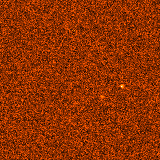
TITLE: GCN/SWIFT NOTICE
NOTICE_DATE: Thu 03 Mar 16 11:15:06 UT
NOTICE_TYPE: Swift-UVOT Processed Image
TRIGGER_NUM: 677495, Seg_Num: 0
POINT_RA: 168.703d {+11h 14m 49s} (J2000)
POINT_DEC: +22.756d {+22d 45' 21"} (J2000)
ROLL: 14.280d
IMG_START_DATE: 17450 TJD; 63 DOY; 16/03/03
IMG_START_TIME: 40156.21 SOD {11:09:16.21} UT, 874.2 [sec] since BAT Trigger Time
FILTER: 10, White
EXPOSURE_ID: 478696172
X_OFFSET: 628 [pixels]
Y_OFFSET: 835 [pixels]
WIDTH: 160 [pixels]
HEIGHT: 160 [pixels]
X_GRB_POS: 788
Y_GRB_POS: 995
BINNING_INDEX: 1
IM_URL: sw00677495000msuni0890.fits
SUN_POSTN: 344.62d {+22h 58m 29s} -6.56d {-06d 33' 28"}
SUN_DIST: 163.37 [deg] Sun_angle= 11.7 [hr] (West of Sun)
MOON_POSTN: 270.57d {+18h 02m 17s} -18.21d {-18d 12' 48"}
MOON_DIST: 107.31 [deg]
MOON_ILLUM: 35 [%]
GAL_COORDS: 218.90, 67.70 [deg] galactic lon,lat of the pointing direction
ECL_COORDS: 160.54, 16.44 [deg] ecliptic lon,lat of the pointing direction
COMMENTS: SWIFT-UVOT Processed Image.
COMMENTS: The GRB Position came from the Window Position in the Mode Command.
COMMENTS: The image has 2x2 binning (compression).
COMMENTS: All 4 attachments are included.
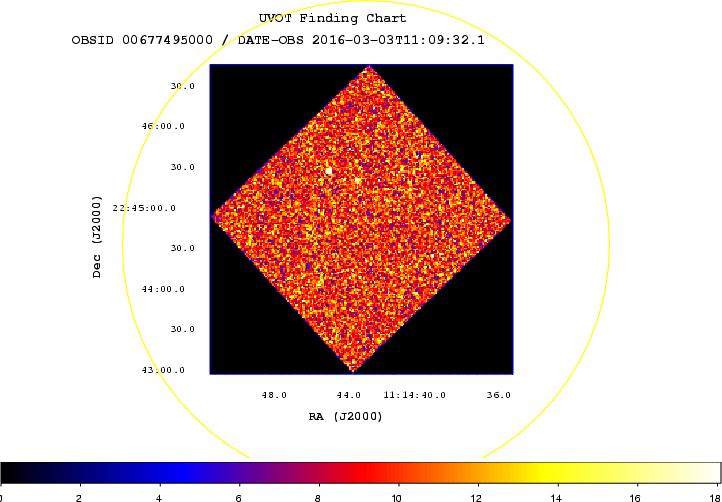
RA(J2000) = 11h 14m 44s Dec(J2000) = +22d 44' 33"with an uncertainty of 3 arcmin (radius, 90% containment, including systematic uncertainty). The BAT light curve shows a single peak structure with a duration of about 0.5 s sec. There is some suggestion of additional peaks at T-1 and T+5. The peak count rate was ~6000 counts/sec (15-350 keV), at ~0.1 sec after the trigger.
RA(J2000) = 11h 14m 48.11s Dec(J2000) = +22d 44' 32.5"with an uncertainty of 2.2 arcseconds (radius, 90% containment). This location is 64 arcseconds from the BAT onboard position, within the BAT error circle. This position may be improved as more data are received; the latest position is available at http://www.swift.ac.uk/sper.
UT start t-T0 Exp. Filter UL (3sigma)
(mid.,days) (s)
10:56:02 0.00110 1*30 Clear 19.8
10:56:02 0.00971 30*30 Clear 21.7
The photometry is based on nearby USNO-B1.0 stars
#T0+[day] MID-UT T-EXP[sec] g' Rc Ic ----------------------------------------------------- 0.00532 11:02:21 540.0 >18.5 >18.6 >18.0 0.01940 11:22:38 2520.0 >19.5 >19.6 >19.0 ----------------------------------------------------- T0+ : Elapsed time after the burst [day] T-EXP: Total Exposure time [sec]
T0+[hour] MID-UT T-EXP[sec] g' Rc Ic ---------------------------------------------------------------------------- 0.43 11:20:38 2610 >20.3 >20.4 >19.6 ---------------------------------------------------------------------------- T0+ : Elapsed time after the burst T-EXP: Total Exposure time We used GSC2.3 catalog for flux calibration.
r = 22.95 +/- 0.31 i = 22.65 +/- 0.23 Z > 21.98 Y = 21.83 +/- 0.36 J > 21.30 H > 21.01These magnitudes are in the AB system and are not corrected for Galactic extinction in the direction of the GRB. The source is located at RA, Dec= 11:14:48.12, +22:44:32.6 (J2000, +/-0.5").
RA (J2000): 11h 14m 48.18s Dec (J2000): +22d 44' 31.7"with an uncertainty of 1.8 arcsec (radius, 90% confidence).
Filter T_start(s) T_stop(s) Exp(s) Mag white_FC 109 259 147 >21.9 u_FC 321 571 246 20.75 white 109 2061 450 >22.5 b 576 2037 136 >19.9 w1 700 2161 77 >20.5 m2 1426 1445 19 >19.5The magnitudes in the table are not corrected for the Galactic extinction due to the reddening of E(B-V) = 0.02 in the direction of the burst (Schlegel et al. 1998).
RA = 11:14:48.06 Dec = +22:44:32.2
Total column: 5.2 (+6.7, -4.1) x 10^20 cm^-2 Galactic foreground: 1.1 x 10^20 cm^-2 Excess significance: <1.6 sigma Photon index: 1.70 (+0.24, -0.22)If the light curve continues to decay with a power-law decay index of 2.36, the count rate at T+24 hours will be 6.7 x 10^-7 count s^-1, corresponding to an observed (unabsorbed) 0.3-10 keV flux of 2.6 x 10^-17 (2.8 x 10^-17) erg cm^-2 s^-1.
T_mid (hr) Exposure (s) Filter Magnitude (AB) ----------------------------------------------------------------------------------- 0.92 5x120 i 22.54 +/- 0.26 1.13 5x120 r 23.06 +/- 0.41 ------------------------------------------------------------------------------------The fields are calibrated to a nearby star at RA=168.701176, Dec=22.745212 from SDSS.
g' = 24.2 +/- 0.1 mag, r' = 24.0 +/- 0.1 mag, i' = 23.9 +/- 0.2 mag, z' = 23.5 +/- 0.3 mag, J > 21.1 mag, H > 20.1 mag, and K > 19.5 mag.Given detections and upper limits are calibrated against SDSS as well as 2MASS field stars. No correction for the expected Galactic foreground extinction corresponding to a reddening of E_(B-V)=0.014 mag in the direction of the burst (Schlafly & Finkbeiner 2011) has been applied.
r > 23.77 i > 23.88 Z > 22.37 Y > 21.77 J > 21.52 H > 21.45These magnitudes are in the AB system and are not corrected for Galactic extinction in the direction of the GRB. Our upper limits are consistent with the GROND measurements (Graham et al., GCN 19144) and confirm that the source was the afterglow of GRB160303A.
RA(J2000) = 11h 14m 50.3s Dec(J2000) = +22d 42' 35.1"with an uncertainty of 2.1 arcmin, (radius, sys+stat, 90% containment). The partial coding was 96%.
g' = 25.2 +/- 0.2 mag, r' = 25.1 +/- 0.2 mag, i' > 24.3 mag, z' > 24.4 mag,Given detections and upper limits are calibrated against SDSS field stars. No correction for the expected Galactic foreground extinction corresponding to a reddening of E_(B-V)=0.014 mag in the direction of the burst (Schlafly & Finkbeiner 2011) has been applied.